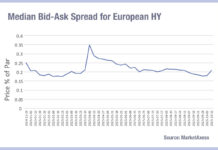Pre-trade transparency is a nirvana for over-the-counter markets, particularly corporate bond trading, which lack the publicly displayed prices of the exchange-traded market.
Unless it reveals too much.
While post-trade tapes, such as the US market’s TRACE, administered by self-regulatory body the Financial Industry Regulatory Authority (FINRA), can provide a benchmark of sorts, bringing data to the execution pre-trade in a meaningful way is far more challenging.

Information is valuable so giving it up can be expensive. However, transparency tends to affect markets in different ways. A new paper by Barclays analyst, Zornitsa Todorova, has found that transparency decreases transaction costs for small trades and newly issued bonds, but it increases costs for large trades and older bonds, by reducing bid-ask spreads for the smallest trades by 5% and increasing them for the largest by 15%.
By taking data from corporate bonds from Europe during a period in which transparency was reduced due to a reporting issue, the same paper found that when transparency drops off, the proportion of agent trading drops by roughly half, from 10% to 5.9%, and in the reverse situation of increasing transparency, agency trading nearly doubles, from 8% to 15.4%.
Transparency effectively reduces the level of risk trading that dealers will take on, as it increase the risk of their position being know in the market, leading to the costs of trading out of that position increasing. Equally, it helps electronic market-makers to trade at speed in smaller size.
This post-trade transparency help the pre-trade decision-making workflow, which has to include the latest data on a bond – and similar bonds – but also needs to assess the relevance that data will have at the point of trade. The frequency of trading and the age of the bond, along with credit rating and issue size, all come into play.
Banks advertising their positions, through axes and indications of interest (IOIs), also helps to steer a buy-side desk’s understanding of who will trade in which direction at what size.
Ultimately, the only test of pre-trade transparency is to go into the market and get a price from a counterparty.
When considering the extent to which transparency can increase, one has to look at the limits at which data be published. For example, in Europe the new framework for a consolidate tape is expected to increase the number of corporate bond transactions reported in real time from the current 8% to more than 80%, according to Barclays.
Not all of those will be frequently traded, and so the value of each report will be limited by the factors noted above.
Pre-trade can get very clear, but that will change the nature of liquidity in the market. Transaction sizes will fall, rewarding electronic trading, which in turn will reinforce transparency levels.
Brokers will move towards an agency model as risk trading costs increase, and interdealer markets will become dominated by electronic market makers who are able consume and process pricing information at a higher speed than other market makers.
It is also likely to drive innovation. The risk profile of certain bonds makes them far more liquid by using list or portfolio trading, and non-competitive (non-comp) trades, through balancing out their risk profile by either blending it with other more liquid bonds, and/or by reducing information leakage around a trade.
Wholesale changes to market structure are mostly driven by regulators and they are not infallible, as MiFID II shows.
It is likely that bond markets will become increasingly transparent over time, but the effect of this transparency will not be linear or consistent for all types of trading.
©Markets Media Europe 2024
©Markets Media Europe 2025















